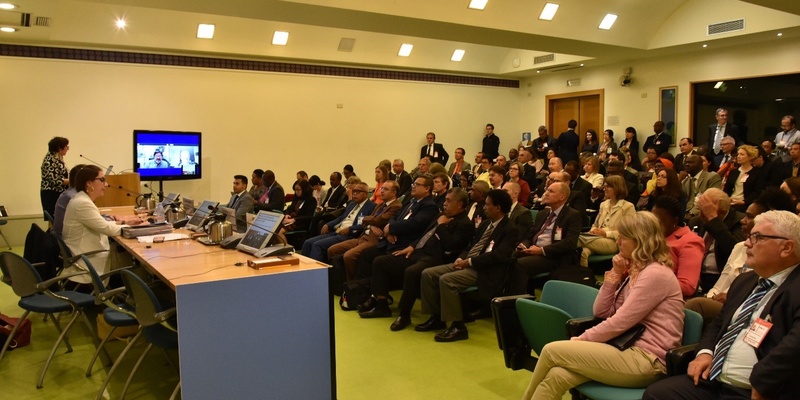CPM-13 side session on gene sequencing and molecular technologies
Posted on Thu, 26 Apr 2018, 06:50

Successfully organized by the IPPC and the European and Mediterranean Plant Protection Organization (EPPO) Secretariats on 17 April 2018 at FAO HQ, the session informed IPPC contracting parties and stakeholders about gene sequencing and molecular technologies for plant pests diagnosis. Early diagnosis and rapid response are crucial in any effort to reduce the risk of entry and spread of plant pests into an area.
Ms Françoise Petter, EPPO Deputy Director, informed the audience that EPPO, one of the 10 Regional Plant Protection Organizations established under the IPPC has in its work a diagnostic programme, as well as organizes Workshops and Conferences. The EPPO Secretariat has thus been following initiatives on high throughput sequencing (HTS), also known as next generation sequencing (NGS) technologies, such as the COST Action DIVAS (Deep Investigation of Virus Associated Sequences) and a project in the framework of Euphresco.
Professor Sebastien Massart from Gembloux AgroBio Tech (Liège University - Belgium) provided an introduction to the recent developments of HTS or NGS technologies and bioinformatics, pointing out that these technologies have drastically changed the research on plant pests. He mentioned that currently four main trends of HTS technologies are driving their future application for plant pests diagnostics, with virus diagnostics at the forefront: the rise of throughput, the decrease of costs, the miniaturization of the machine and the application in human clinical diagnostics. He provided an overview of a framework for the evaluation of biosecurity, commercial, regulatory and scientific impacts of plant pests identified by HTS or NGS technologies. Hence recent advances in HTS or NGS technologies and bioinformatics have generated huge new opportunities for discovering and diagnosing plant pests, and more specifically viruses and viroids - plant health stakeholders have undoubtedly benefited from these new methodologies; but at the same time, the community faces now substantial bottlenecks, namely the biological characterization of the newly discovered viruses and the analysis of their impact at the biosecurity, commercial, regulatory, and scientific. He highlighted several international initiatives on this aspect, including some with the involvement of the IPPC Secretariat
Dr Mike Rott from the Canadian Food Inspection Agency (Canada) joined the side session via videoconference and provided some practical applications on the use of HTS or NGS in plant pests diagnosis. He showed that the Canadian post-quarantine entry facility for imported fruit trees, grapevine, small berries and others, makes screens for quarantine and invasive viruses and viroids, before they are granted entry. As mentioned, conventional testing can take up to 3 years, primarily due to the lengthy period of time required to complete infield bioassays, often considered the gold standard for plant virus detection. Performing these tests is, slow, labor intensive, and costly for the regulator and inhibits timely access to new varieties by the industry and growers. Over the last several years, researchers in Canada have been exploring massively parallel sequencing techniques such as NGS, as a tool to fully characterize the number and species of viruses and viroids infecting individual plants, rapidly and cost effectively. The Centre for Plant in Sidney, British Columbia team has developed a detailed set of laboratory methods and an in-house developed bioinformatics tool for sample management and virus detection, called Virtool.
Dr Mark Whattam, Director within the Plant Import Operations branch of the Australian Government Department of Agriculture and Water Resources, joined the session via video conference and mentioned that rapid and reliable detection of phytosanitary viruses and viroids is critical for protecting plant health worldwide. Existing phytosanitary testing protocols rely on time-consuming, ambiguous and costly biological indicators, serological tests and molecular assays that require knowledge of infecting viral pathogens. He outlined that HTS or NGS, along with bioinformatics provide a new way to identify all viruses and viroids in a single test. However as with most new technologies, there is an important transitional period to fully understand the limitations and address critical control points in applying the method from research laboratory to routine diagnostic deployment. He also emphasized that further work is required to optimize the HTS or NGS system and to generate comparative evidence evaluating NGS against existing phytosanitary protocols to give policy makers confidence in this new diagnostic test. He also mentioned that the CPM play an important global role in the international harmonization of accepted standards and regulatory policies and that CPM-13 had just agreed to the topic to make a CPM Recommendation on NGS technologies in plant diagnostics in phytosanitary context.
Dr Adriana G. Moreira, Standard Setting Officer from the IPPC Secretariat, emphasized that the ability to detect a plant pest varies with the quality and specificity of the detection tools. Regarding HTS or NGS technologies (or deep sequencing), these technologies have provided a very powerful alternative for detection and identification of organisms without a priori knowledge - these technologies enable a new and comprehensive approach to the detection and characterization of pests in a biological sample. However, research findings based on NGS technologies may have significant implications within a phytosanitary framework - not all organisms associated with plants are pests; some may be mutualists providing benefit to the host plant or commensal agents. She stressed that the proper interpretation of results is the biggest challenge in the phytosanitary context, as it requires very large databases of known pests as the reference for comparisons, as outlined by the IPPC TPDP. Links were made between IPPC adopted ISPMs portfolio such as for ISPM 2, ISPM 6, ISPM 8, ISPM 11, ISPM 17, and ISPM 27. Therefore, if NGS is to be used for phytosanitary purposes, significant validation data have to be available. And criteria for its use and policies for the interpretation of the results need to be developed to enable appropriate regulatory decisions.
The recording of this side session is available here.



